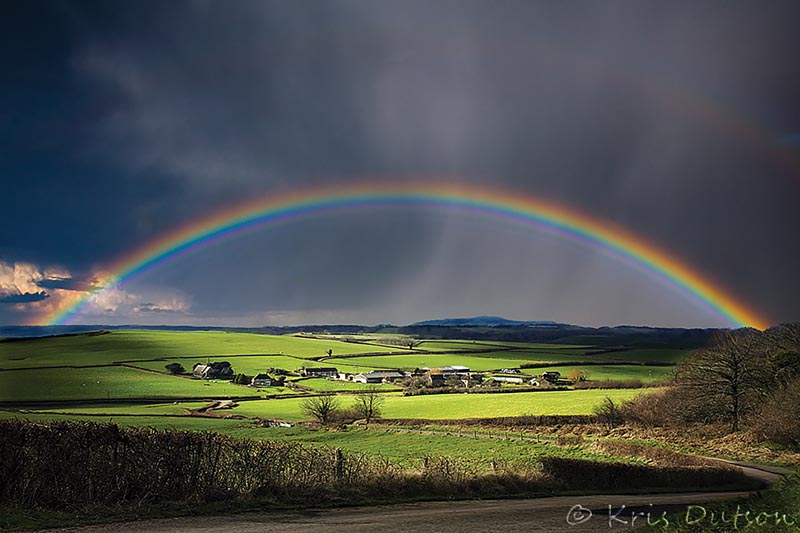Chasing Rainbows, Part 1
Winter
2017
Physics Puzzler
Chasing Rainbows, Part 1
Donald Simanek, Emeritus Professor of Physics
Lock Haven University

Also see: Chasing Rainbows, Part 2
One St. Patrick's Day, thinking of leprechauns and pots of gold, this puzzle came to mind. In my search for challenging physics puzzles, I look for those that are relatively simple, and for those for which you won't find correct answers with a simple web search. Yet, with a little thought—and a little physics—the answer, when found, seems obvious.
Here's a question often seen on the web. Many answers found there are simplistic and unconvincing. Textbooks seldom raise the question.
How far away is a rainbow?
- As far away as the cloud of water drops that forms the rainbow.
- Just nearer than distant objects, such as mountains.
- As far away as the horizon.
- As far away as the sun.
- At infinity.
- Well beyond infinity.
- There's no way to determine its distance.
- As far away as you want it to be.
You need to know this before you set off to find that pot of gold at the end of the rainbow. Explain and justify your answer.
Discussion and answer
On the web I've seen many different answers given to this question, defended with simplistic or insufficient arguments. My discussion of this is at odds with most of the answers found there.
First, how does one define "rainbow," "image," and "distance"? Is the rainbow an image in the sense the word is used in physical optics? Clearly there's a replica of the rainbow cast on the retinas of our eyes. The rainbow image can also be captured with a camera. Is the rainbow itself a real image? If so, what is it an image of? How does one measure distance to such an ethereal thing?
Some argue that no two people see the same rainbow, since they each see light coming from different collections of water drops. But suppose two people stand side by side and look at their image in a large mirror. Each sees light that was reflected from different places on the mirror surface, yet neither denies they are looking at the same image of themselves, and they agree on the details of it. That image is a virtual image, for the rays reaching our eyes arrive from directions that converge back to points behind the mirror where the image appears to be located. But there's nothing back there. Still, by extrapolating those rays behind the mirror, we can locate where the rays diverge from, and we can say with conviction, exactly where the image is located in space.
Let's dispose of the question "Is the rainbow an image of something?" Yes. It is an image of the sun. Images can be distorted, as are the images in a fun-house mirror. A rainbow is an image of the sun, smeared around a circular arc, and also radially smeared into colors by dispersion in the water drops. Since the rainbow has a definite geometric size and shape, we can legitimately ask where it is located.
We use stereoscopic (two-eyed) vision to judge the relative distance to objects. Unfortunately, rainbows are too far away for our visual stereoscopic judgment, since our eyes are separated only 2.5 inches. But we could use the same principle to triangulate the distance if we observe the rainbow from two positions sufficiently far apart. If we do this we are in for a surprise.
Of course rainbows require a cloud of water drops, and that cloud must be on the opposite side of the sky from the sun. This is not fundamentally different from the fact that a mirror must be located in front of you for you to see your image. If you go behind the mirror you will see no image. If you go beyond the water drop cloud you won't see the rainbow. Can we say that the image in a mirror is at the surface of the mirror? No. Just as the image in the mirror is behind the mirror, we will find that the rainbow is behind the water drops, i.e., at a greater distance from us.
To understand exactly how much greater, we delve into the math in "Chasing Rainbows, Part 2" in the Spring 2017 issue of The SPS Observer.
More information
- Rainbow formation. The Physics Classroom.
- Rainbow stereoscopy. Science Animations.
- The mathematical physics of rainbows and glories. John A. Adam, Physics Reports 356 (2002) p. 229-365.
- All about rainbows, double rainbows, circular rainbows! Skulls in the Stars.
- Rainbow. Hyperphysics.
- Greenler, Robert. Rainbows, Halos and Glories. Cambridge Univ. Press, 1980.
For other examples of these concepts, check out:
2013 SPS Science Outreach Catalyst Kit
2014 SPS Science Outreach Catalyst Kit
Correction
An alert reader, Carl Reiff, noticed my answer to puzzle 2 in the Fall 2016 issue had a misprint in the last sentence. It should have read, "The barycenter is again important here. The earth is closer to the sun at full moon. At noon at full moon, the center of the earth is 2×4671 = 9342 km closer to the sun than it is at noon at new moon. So you are also that much closer to the sun at noon at the time of full moon." //
Feedback
Feedback is appreciated from readers. E-mail dsimanek [at] lhup.edu. If you have a favorite physics puzzle that is not well known, not easily found on the web, or in the many published physics problem books, send it along. Include your answer, too, if you have one. If used, we'll credit you. I especially like puzzles that can be solved with insightful and simple arguments, preferably with minimal mathematics.
